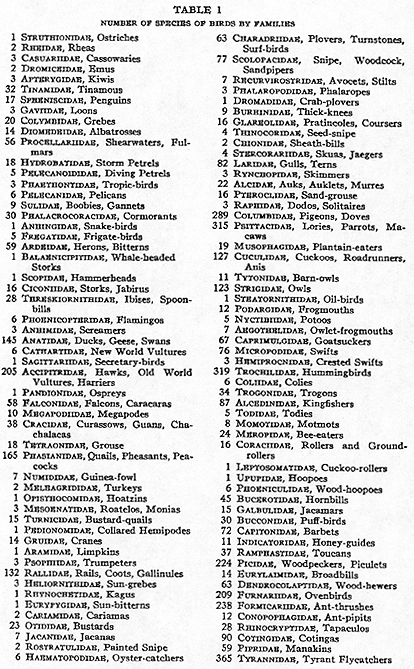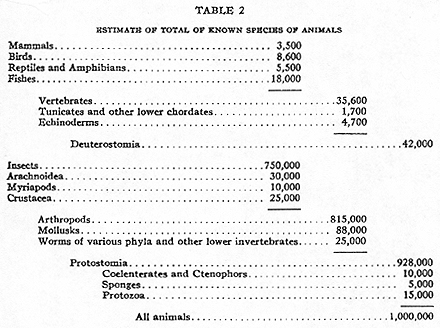
http://people.wku.edu/charles.smith/biogeog/MAYR1946.htm
The Number of Species of Birds
by Ernst Mayr (1946)
Editor Charles H. Smith's Note: Original pagination
indicated within double brackets. My thanks to The American Ornithologists'
Union for permitting the reprint. Citation: Auk 63 (1946): 64-69.
[[p. 64]] "How many
species of birds are known?" is a question the bird taxonomist is asked
very frequently. The answer, up to now, has had to be a guess. It is for
this reason that I decided to count the species, family by family, on
the basis of the best available information.
In the tenth edition of the 'Systema Naturae' (1758), the first work in which the species concept is consistently applied, Linnaeus enumerates 564 species of birds, known to him from all parts of the world. In the subsequent 150 years a number of additional counts were published, each one to be quickly superseded by a newer one. The last of these counts is contained in the fifth and final volume of Sharpe's 'Handlist' (1909). The number admitted by Sharpe was 2,810 genera and 18,937 species. This figure, however, includes not only the fossil species, but also treats all subspecies as full species. It is, therefore, obvious that the actual number of species of birds must be considerably below Sharpe's figure, even though about 400 additional good species have been described since 1909. In 1935 I [[p. 65]] made a careful estimate and arrived at the figure 8,500 (Mayr, 1935). Other recent authors have made estimates which vary from 10,000 (Stresemann) to 16,000. It is obviously desirable to replace these rough estimates by an accurate count.
Most helpful in this count were the recent standard works on bird taxonomy, such as Peters's 'Check-list of the Birds of the World' and Hellmayr's 'Catalogue of Birds of the Americas.' However, these works were not followed blindly, and modifications were made wherever more recent revisions were available or where an examination of the material led me to different conclusions. In most cases these changes consisted in reducing to the status of subspecies allopatric forms regarded as full species by the earlier authors. As far as the Old World families are concerned, the subsequently listed counts are based directly on the collections of the American Museum which were rearranged during the past ten years by Dr. J. P. Chapin and myself with the help of Messrs. J. Delacour, H. Birckhead, D. Amadon, M. Moynihan, and C. Vaurie. This involved the complete revision of many families, the results of which have been published only in part. Mr. C. K. Nichols had the kindness to count for me the species in the following American families: Dendrocolaptidae, Furnariidae, Formicariidae, Conopophagidae, Rhinocryptidae, Cotingidae, Pipridae, Tyrannidae, Oxyruncidae, and Phytotomidae.
The principal difficulty one has to face during a count of the species of birds in the world is to decide, in the case of the many borderline forms, whether to consider them species or subspecies. I was guided in my decisions by the modern biological species concept which does not require morphological intergradation between geographical races, but only the probability of interbreeding. To list a doubtful form as a species, if it is really only a subspecies, is considered by me just as serious an error as to list a form as a subspecies, which really deserves species rank. If anything, I have erred on the conservative side. The final count will probably be lower than mine by about 100 species.
The sequence of families follows Wetmore (1940) in the non-Passeres, but follows in the Passeres a system which was developed by the members of the staff of the Department of Birds at the American Museum (R. C. Murphy, J. T. Zimmer, E. Mayr, J. P. Chapin, and J. Delacour) for use in the new synoptic exhibits of the Museum. This system follows closely the generally adopted classifications of Sharpe's 'Handlist' and other standard works. It places the primitive babbler-thrush group near the beginning and the oriole-corvid-
[[p. 66]]

[[p. 67]]

bird of paradise group near the end. Portmann's recent work on the brain of the Corvidae supports this sequence. The reduction of the tenth primary is not considered by us as decisive a character, as it is by some other recent authors.
The total figure of 8,616 species is surprisingly close to my previous estimate. I judge that the figure is probably within five per cent, and certainly within ten per cent, of the final figure. The least accurate figures are those for the woodpeckers, larks, warblers, titmice, and finches. Whatever changes may occur in the future will be due primarily to taxonomic revaluations, that is to shifts from specific to subspecies status and vice versa. The period of new discoveries is practically at its end. I doubt that in the entire world even as many as 100 new species remain to be discovered.
Only twenty-three families contain 100 or more species. These are the Muscicapidae sensu lato (1360) [with the subfamilies Turdinae 304, Timaliinae 261, Sylviinae 386, Muscicapinae 328], [[p. 68]] Fringillidae (426), Tyrannidae (365), Trochilidae (319), Psittacidae (315), Columbidae (289), Ploceidae (263), Formicariidae (238), Picidae (224), Furnariidae (209), Accipitridae (205), Thraupidae (197), Phasianidae (165), Meliphagidae (160), Anatidae (145), Rallidae (132), Cuculidae (127), Strigidae (123), Pycnonotidae (109), Parulidae (109), Nectariniidae (106), Sturnidae (103), and Corvidae (100).
On the other hand, among the total of 160 recognized families there are sixty-six families with less than ten species. The total for the non-Passeres is 3,523 species and that of the Passeres 5,093 species.
About seventy-five per cent of these species of birds are polytypic, that is they are composed of more than one subspecies; consequently the number of subspecies of birds is considerably higher than the number of species. I estimate that the number of valid subspecies of birds described by the end of 1945 amounted to about 28,500. This figure is increasing annually by about 200.
To give an estimate of the number of genera is very difficult in view of the current revolution of the generic concept. Ten years ago I estimated that about 2,600 genera of birds were recognized (Mayr, 1935). This amounts to about 3.3 species per genus. In recent revisions of the Pycnonotidae, Anatidae, Sturnidae, and Corvidae, Delacour, Mayr, and Amadon recognize an average of 4.75 species per genus. If this average were consistent it would result in the recognition of only 1,800 genera for the known 8,616 species of birds. Even so, birds are much more finely split generically than, for example, most groups of insects or plants.
A comparison of the number of species of birds with that of other groups of animals is appended. These figures are based in part on Hesse's (1929) tabulation, but utilize more recent data in several groups (for example, Smart, 1940). In the vertebrates only full species are counted; the figures are therefore much lower than those given in contemporary textbooks which do not distinguish between species and subspecies. The grand total for all animals was deliberately rounded to one million, by adjusting the estimates of various classes, to indicate that the figures are estimates and not actual counts. The disparity of the share the insects have in the grand total (75 per cent) is likely to get worse as time goes on. With new species of insects still being described even from our back yards, and with only an infinitesimal proportion of the tropical insects known, the frequently-made statement that only ten per cent of the species of insects are known, may be well-founded.
[[p. 69]]

REFERENCES CITED
HESSE, R.
1929. Bericht über das "Tierreich." Sitzungsber.
Preuss. Akad. Wiss., Berlin: XL-XLIV.
MAYR, E.
1935. How many birds are known? Proc. Linn. Soc.
New York, Nos. 45-46: 19-24.
SHARPE, R. B.
1909. Handlist of the genera and species of birds,
5: xii.
SMART, J.
1940. Entomological systematics examined as a practical
problem, in Huxley, The New Systematics: 477.
WETMORE, A.
1940. A systematic classification for the birds
of the world. Smiths. Misc. Coll., 99 (no. 7).
*
*
*
*
*